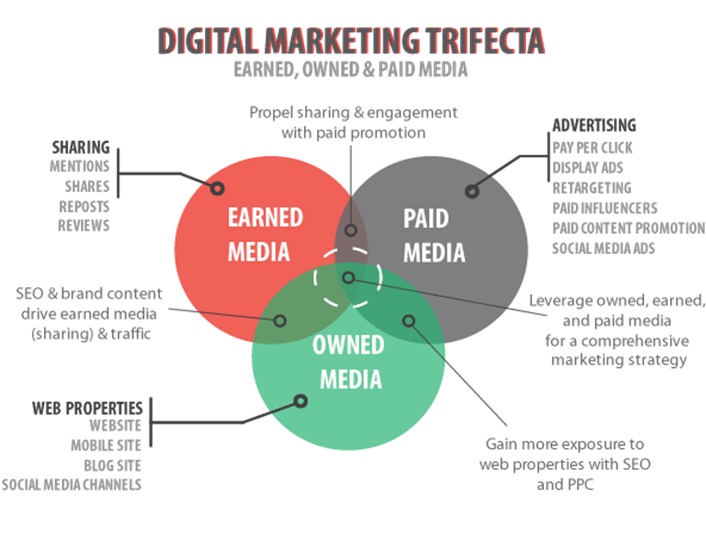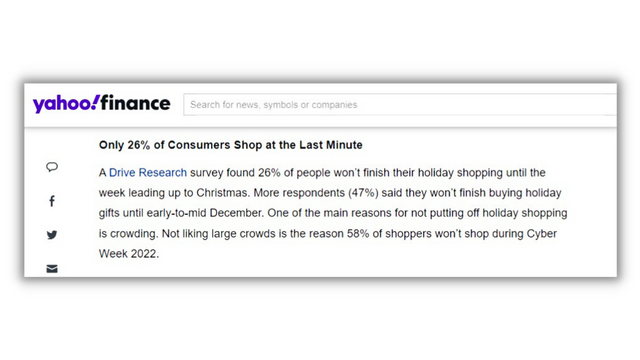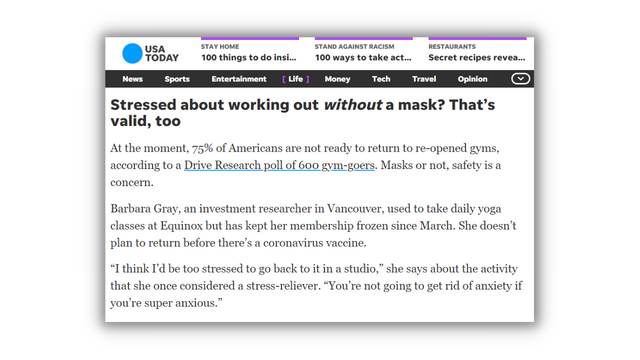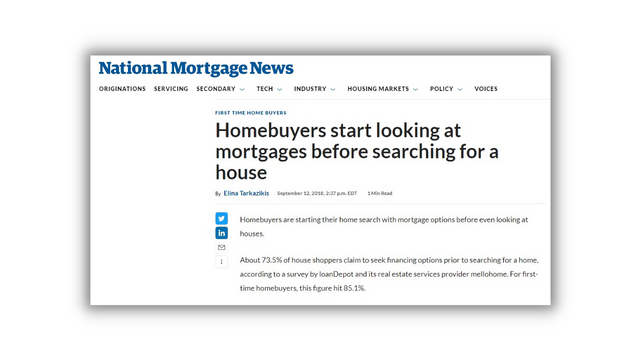
Want more media attention in 2025? You’re not alone.
With more brands vying for headlines than ever, earning meaningful press coverage takes more than just a well-written press release. You need data, relevance, and a newsworthy angle that captures attention fast.
In this post, we’ll walk you through how to stand out to journalists, what today’s media outlets are really looking for—and share our go-to strategy (aka our secret hack) for getting featured in top-tier publications. Let’s dive in.
What is Press Coverage?
Press coverage or earned media refers to the mention of a brand by a third-party source such as media publications, online newspapers, television, bloggers, influencers, customers, etc.
Typically, press coverage is earned when a brand releases newsworthy information in the form of a press release and a journalist finds the information interesting and valuable enough to include in a story (or even writes an entire story based on exclusive research).
Examples of earned media include:
- Media, blogger, and influencer relations
- Media/press placements
- Social media shares, reposts, and retweets
- Reviews and testimonials
- Interviews with the news/media
Earned media is part of a much larger trifecta that makes up a digital marketing strategy. It assists in getting more white hat backlinks, improving search engine rankings, and increasing brand awareness.

Source: Titan SEO
The Key Takeaway: A perfect marketing strategy includes a component of public relations and media coverage. Not only does it help grow brand awareness, but earning backlinks from top news outlets helps your website’s domain rating – leading to higher search engine rankings.
Why Press Coverage Matters in 2025
Positive press coverage has a huge impact on the success of a business. From increased visibility to a stronger online presence, here are our biggest reasons behind getting more press coverage this year.
Visibility and Awareness
First off, press coverage generated by accurate survey data enhances a brand’s visibility.
This visibility leads to increased awareness of a brand’s activities, products, and/or services. Aside from gaining more public perception, press coverage as a result of survey findings helps brands reach a broader audience.
Credibility and Trust
Perhaps one of the best aspects of increased press coverage using survey data is being mentioned in trustworthy news sources.
Think of this as a third-party endorsement for a brand’s credibility. Again, being referenced in larger, credible new sources not only enhances trust but also aids in continued visibility.
Influence on Stakeholders
Just as negative press coverage drives potential stakeholders away from a brand, positive press coverage does wonders when it comes to attracting people to your brand.
These groups can include investors, customers, partners, employees, and related teams. When a brand has the ability to attract a diverse group of stakeholders, this also sheds a favorable light on them.
Crisis Management
During a crisis, brands need to ensure they’re utilizing the press wisely to correct the issue at hand.
Whether the crisis is small or large, press coverage can make or break a brand during this time. Aside from having teams ready to handle crises, it’s important to begin creating an effective public response.
Media communication during this time is key and must be handled wisely. Thankfully, good press coverage can rectify a branding crisis and create positive perspectives.
SEO and Online Presence
As we know, the goal of a brand running surveys to gather press coverage is to attract consumers and positive media attention. Doing this leads to backlinks and other references on the web, creating that attention.
Legitimate news sources including backlinks to a brand’s site can have a large impact on its search engine ranking and how many users view it. AKA, more people will have access to the site!
Secondly, backlinks and related mentions boost shares on social media and increase online engagement levels.
This also helps increase a brand’s online visibility. Naturally, this will result in reaching more consumers and having them interact with a brand.
I recommend reading our blog post White Hat Link Building Strategies for other tips on how to get more backlinks for your website.
The Key Takeaway: Positive press coverage, especially generated through accurate survey data, significantly impacts a business by enhancing visibility, credibility, and trust. It also influences stakeholders positively, aids in crisis management, and contributes to improving SEO and online presence through backlinks and increased engagement.
What Journalists Look for in Press Pitches
On any given day, the average journalist may receive up to 100 pitches from PR professionals. I don’t know about you, but I definitely wouldn’t read 100 unsolicited emails every day.
Given the steep competition in a journalist’s inbox, marketers have to get creative when it comes to drafting an attention-grabbing subject line and a short and sweet email pitch.
When pitching a story to the media, it’s important to think with your journalist hat on.
Is the story you’re trying to tell actually newsworthy? Remember, it’s not about what you find interesting, it’s about what the audience of the news outlet finds interesting.
A recent study conducted by FRAC.TL found that top-tier journalists look for:
- Relevant content (93%)
- Exclusive research (59%)
- A trustworthy methodology (54%)
What does this mean for your brand?
To be successful in obtaining media placements from your next PR survey, your company may want to consider using one (or more) of these key components.
1. Prioritize press release key elements
According to Jenna Guarneri, President at JMG Public Relations crafting a successful media pitch is a crucial skill for anyone looking to gain media coverage. I can tell you that editors and journalists receive countless pitches every day, so it’s important to make your pitch stand out.
Here are the key elements of a good media pitch:
- Personalization: A good media pitch should be tailored to the individual journalist or media outlet you are pitching to. Research their previous articles and make sure your pitch is relevant to their beat.
- Compelling hook: Your pitch should have a strong, attention-grabbing hook that entices the journalist to read on. This could be a unique angle, a timely news hook, or a compelling story.
- Clear and concise: Keep your pitch brief and to the point. Journalists receive countless pitches every day, so make sure yours is easy to read and understand.
- Relevant details: Provide relevant details about your story or product, including key statistics, quotes, or visuals that will help the journalist understand why your story is newsworthy.
- Call to action: End your pitch with a clear call to action, such as offering to set up an interview or providing additional information. What do editors/journalists look for in a pitch? Journalists are always looking for great stories that will engage and inform their audience.
- Relevance: Journalists are interested in stories that are relevant to their audience and their beat. Make sure your pitch is targeted to the right journalist or media outlet and is a good fit for their audience.
- Newsworthiness: Journalists want stories that are newsworthy and have a strong hook. Think about what makes your story or product unique and why it would be interesting to their readers or viewers.
- Timeliness: If your story is tied to a current event or news cycle, that can make it even more appealing to journalists. Make sure to highlight any timely angles in your pitch.
- Credibility: Journalists want to work with credible sources and brands. Provide any relevant data, research, or expert quotes that will help establish your credibility.
- Conciseness: Editors and journalists receive a lot of pitches, so make sure yours is brief and to the point. Include all relevant information in a clear and concise manner.
2. Focus on newsworthiness
If a press release isn’t relevant, your email will be quickly moved to the trash bin.
When drafting a newsworthy PR survey, it’s essential to work backward.
Start with the topics that journalists will find the most interesting and craft questions that will lend insight and create attention-grabbing news headlines.
How exactly does Drive Research know what’s newsworthy?
Our PR survey company monitors the media to stay on top of what’s trending. We scour the internet to find gaps in what the media may be missing and fill them with new market research findings.
2. Offer exclusivity
Chances are those 100 email pitches that clutter journalists’ inboxes were also sent to hundreds of other journalists.
Instead of sending your press release out to hundreds of writers, your brand may want to consider offering one individual journalist or media outlet an exclusive to make your information even more enticing.
Plus, exclusivity helps make the writer feel more invested and helps to forge positive relationships with the news/media for future earned media opportunities.
3. Work with a third party
The increase in popularity of DIY market research technology has made in-house surveys even more possible than before.
While it may seem easy to conduct a market research study in-house to cut costs, finding the best PR survey company is important to ensure a trustworthy methodology.
Hiring a public relations market research company eliminates bias and helps the journalist feel at ease that they’re reporting accurate and reliable information.
Other than eliminating and reducing any potential bias, working with a third-party PR polling company allows the research to be done quickly, professionally, and with a fresh perspective.
Learn more about the anticipated costs in our blog post, The Cost of a PR Survey with a Third Party.
4. Add personality
According to Alessandra Schade, Arts and Culture Writer at Paper Magazine, it’s important to write your pitch with the same stylistic flair as you will your article.
The clarity of the pitch is your foundation, but a few pithy sentences showcasing a distinct ability to cover the topic you’re presenting with nuance and finesse is the “secret sauce” of what you’re really selling – which is you.
5. Emphasize the pitch’s importance
According to Rachel Sonis, Associate Editor at TIME Magazine, a great pitch is the tension between accessibility and specificity.
- How does it affect and resonate with people’s everyday lives?
- Does the tone explain the subject matter thoroughly (with sources to back it up), so that a reader with no prior knowledge can follow along?
- Most importantly, how does this specific moment or bite-sized nugget explain the larger implications and ramifications of the story?
These are the questions that, when kept in mind, make a successful pitch.
6. Offer a clear outline for the story
Cameron Getty, Assistant Photo Editor at Wired Magazine believes a pitch should present the story you plan to narrate, rather than the subject you wish to investigate.
Outline the core timeline you intend to build, identify your primary characters, and provide glimpses of the scenes that will come to life.
While you don’t need to have the entire narrative arc figured out when pitching, offer some hints that it will be an engaging and fulfilling story. Additionally, make sure to communicate the broader significance or impact of your tale.
The Key Takeaway: It’s critical that media pitches include a developed idea of the proposed story. Journalists simply don’t have the time to sift through half-developed ideas. To up the chances of a pitch getting picked up, including all elements of the story idea before hitting send.
How to Make a PR Pitch Stand Out
According to New York Times Senior Staff Editor, Sarah Bahr, reporters and editors may get hundreds of emails each day, so it’s important to take every opportunity you can to stand out.
Here’s how Bahr recommends writing a pitch that actually makes its way onto a website:
- Write a compelling email subject line: You can never go wrong with being direct and starting with the word “Pitch.”
- Provide a headline: It’s good to think about what the headline for your proposed story would be, which also helps you focus your idea. Plus, the point of a headline is to make the reader click, so if you can make an editor do that, you’re already halfway there!
- Articulate how your pitch is a good fit specifically for the journalist you are targeting and their publication: Indicate that you know what they cover and reference recent stories they’ve written, if applicable. No one likes a generic pitch sent to a dozen journalists. There’s a greater payoff in taking the extra time to tailor a pitch for a single journalist/publication than attempting to save time by writing one, sending it to 12 journalists, and having all 12 immediately delete it.
- Explain why the editor should write your pitch right this moment: The person you’re pitching shouldn’t have to reach the bottom of the email to discover that your pitch is tied to an event in a couple of days. What’s so compelling about your idea that it cannot wait to be told? Because in the lives of busy writers and editors, being banished to the “Yeah, that’s a good idea, maybe I’ll do something when I’m less busy” is equivalent to a “will never happen.” There will always be fresh stories that need to be written right this instant!
The Key Takeaway: In order to write a pitch that stands out and gets attention from journalists, it is important to have a compelling email subject line, provide a headline for your proposed story, tailor the pitch to the specific journalist and publication, and explain why the pitch is time-sensitive and should be written immediately.
Secret Hack: Get More Press Coverage with PR Surveys
When selecting what stories to publish, news outlets look for pitches with relevant content and exclusive research by a trusted source. A custom PR survey easily checks all of those boxes.
A public relations survey is a publicity strategy that is commonly used by major brands to get more press coverage.
Through PR polling, a brand can sponsor a research study, typically in partnership with a third-party market research firm, which results in proprietary, newsworthy research findings.
There are several benefits of investing in PR market research rather than a paid digital advertising campaign. There might include:
- Cost-Effective and High ROI: PR polling is known for its high return on investment due to its many uses and low cost compared to paid media such as social media advertising.
- Increased credibility when shared by trusted sources: Consumers know that advertising can be deceptive, which is why being featured by a credible media outlet builds trust with your audience.
- Establish your brand as an industry expert: PR surveys allow your company to be considered a thought leader by contributing new, proprietary information to your industry.
- Increased exposure and brand awareness: Your company’s paid advertisements can only expand so far, while public relations market research allows your brand to build awareness among new audiences.
- Collect customer testimonials: During a PR study, you’ll have the opportunity to collect reviews and testimonials that can be featured in a press release, on promotional materials, in a blog, or on your website.
Watch this short video to learn more about the benefits of public relations surveys.
The Key Takeaway: There are many reasons to conduct PR market research. Not only will the exclusive research attract news outlets, but they are cost-effective to execute and help signify your brand as a thought leader.
Examples of Getting Press Coverage with Surveys
When it comes to developing an earned media strategy, a PR survey is a great place to start. And Drive Research is no stranger to leveraging exclusive research for media coverage.
Below are just a few examples of studies conducted by our PR survey company that has resulted in media pickups from publications such as USA Today, Yahoo News, CNBC, The Boston Globe, and more.
Drive Research – Cyber Week
For the past several years, Drive Research has surveyed over 1,000 consumers to learn more about their shopping habits as it relates to Black Friday, Small Business Saturday, and Cyber Monday.
Plus, we have been able to build upon our findings from 2020, 2021, and our most recent 2022 survey to compare how these behaviors have evolved over time.
The results earned over 70 backlinks from media publications and websites such as:

Drive Research – Reopening Gyms Post-Pandemic
In the summer of 2020, there was a long list of unknowns facing businesses.
While some could adapt to a socially distanced business model, there were many industries that could only succeed by allowing in-person interactions.
This was especially for fitness centers. To better understand what people needed from fitness centers to feel more comfortable going to the gym amidst the pandemic, we surveyed over 600 gym-goers.
The survey discussed masks, membership fees, expectations, and more.
The results earned over 60 backlinks from media publications and websites such as:

Advance Local – COVID-19’s Impact on Consumer Habits
Advance Local used Drive Research PR COVID-19 survey insights for a webinar and form fill download on the website.
On average, the client only saw 20 to 30 sign-ups for the weekly COVID sessions. Our PR survey webinar drew over 500 sign-ups.
Our Marketing Manager, Emily Rodgers also sat down with Spectrum News anchor, JoDee Kenney to share the findings from this survey.
Drive Research – Travel and Tourism
In May of 2021, COVID-19 vaccination programs continued to ramp up across the United States.
As a result, many Americans were eager to start traveling again. Drive Research surveyed nearly 600 respondents to learn more about their travel plans and what health and safety protocols they would need in place to feel safe while traveling domestically.
The results were featured in news outlets and media publications such as:
Flock Freight – Inefficiency is Breaking Supply Chains
Flock Freight leveraged a content survey to uncover existing inefficiencies within traditional freight mode and how their solutions solve shippers’ most pressing challenges.
The insights fueled a content-driven marketing campaign with the following components:
- Lead generating, downloadable report
- Webinar with hundreds of attendees
- Animated infographic
- Blog posts
As a result of our combined efforts, the marketing campaigns have generated 75+ leads for Flock Freight, so far.
Loan Depot – Homebuyers Shopping for Loans
loanDepot, the nation’s second-largest mortgage originator, uses Drive Research PR surveys to roll out infographics and press regularly.
Here is a feature on National Mortgage News, an infographic on the blog, and a PR Newswire press release.

Drive Research – Coffee Drinkers
At Drive Research, we love coffee almost as much as we love data and statistics. So, why not combine the two?
Our market research team ran a national survey with 1,500 respondents to gather fresh data on their coffee-drinking habits.
The study touched on how often people drink coffee, what types of coffee they prefer, when they switch to decaf, and more.
The results were featured in over 10 media publications and websites such as:
Drive Research – NY Buffalo Bills Stadium
The New York Buffalo Bills had their $1.4 billion proposal to build a 60,000-seat stadium approved.
Before development began, our market research company was eager to hear from Bills fans on this topic. We surveyed over 1,000 Buffalo residents to learn what they hoped the new stadium would include.
The results were featured in Front Office Sports and an animated infographic.
Other Ways to Leverage PR Market Research
When it comes to investing in PR market research, our clients see the benefits of their survey findings extend far beyond earning press coverage.
PR survey findings can also be useful for:
- Powering marketing campaigns
- Collecting customer testimonials
- Creating your website copy
- Writing blogs
- Hosting webinars
- Sharing research-inspired content on social media
- Inspiring promotional materials (i.e., fliers, brochures, etc.)
- Storytelling with a branded infographic
Whether your company is interested in a PR survey simply to capture media attention or to maximize your ROI from the market research and invest in all of the above, your brand is sure to find value in exploring the benefits of PR market research.
The Key Takeaway: Aside from earning more press coverage, PR surveys also provide data that can be repurposed into all facets of your marketing and sales strategies.
Get More Press Coverage with Drive Research
Drive Research is a PR market research company. Our services extend across the U.S. and the world. Our market research firm has worked with Fortune 500 brands, helping deliver insights, action items, and ROI on their survey efforts.
Questions about how to make surveys work for PR?
Contact us below for a detailed proposal for your project.



